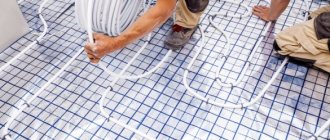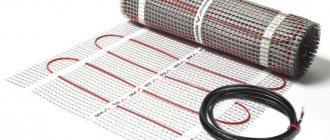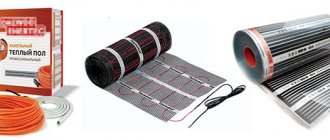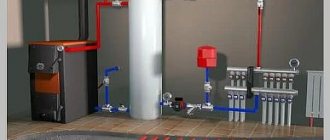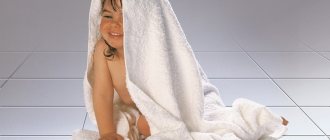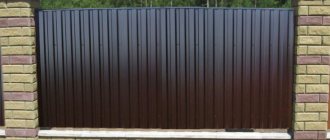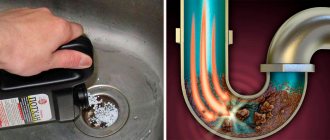The air temperature in a living space directly affects not only health, but also human well-being. To maintain a comfortable atmosphere in an apartment or house, an additional heating method is increasingly being used - infrared heated floors. The system is an advantageous alternative to other types of heating elements and does not require complex installation. The rating of the best infrared heated floors for 2022 will help you choose the appropriate heating device.
Water heated floor
Water heated floors are the most common system for heating an individual home. Its important component is pipes made of polypropylene or metal-plastic. The system also includes a circulation pump, a manifold-mixer, and three-way valves (according to the number of water circuits).
Here's how this system works: the heated liquid moves along the heating circuit and transfers its heat to the screed. The cooled water goes back, flows into the boiler, heats up again - the cycle repeats. Limiters built into the system prevent the floor from heating above the set temperature.
Pros and cons of a water heated floor system in a private house
| Flaws | Advantages |
| Difficult installation. If using a concrete screed, you need to wait at least a month until it dries completely. Need a boiler room. | Compatible with different types of floor coverings. |
| The initial costs will be several times (3-5) more expensive than an electric floor. | Very effective system. The temperature of the circulating fluid is 35-50 degrees, this greatly reduces heating costs. |
| When this is the only way to heat a house, complex calculations are needed. | May be the only SO at home. |
| In case of leakage, complete dismantling of the covering and removal of the screed will be required. | Does not generate an electromagnetic field. |
| A wide variety of floor coverings are compatible with hydronic heated floors, and you can lay a carpet on it. | Does not dry out the air in the room. |
Water floors are divided according to the type of installation: usually the pipes are poured into a screed, but there are also flooring systems, wooden or polystyrene.
sly2kFORUMHOUSE Member
A 50 mm board is placed on top of the logs, recesses for laying tubes are milled into it, then foil is laid into the recesses (as waterproofing and for better heat distribution), and metal-plastic pipes are laid. All this is covered with boards (20 mm pine), the boards are coated with polyurethane varnish on both sides.
Each type of water heated floor is good in certain conditions.
Lightweight and quickly warmed up, the flooring system is considered an ideal solution for panel houses.
The polystyrene system is recommended for wooden floors.
The concrete system is chosen for capital, powerful buildings. It, as already mentioned, is more expensive, but it is an indispensable element of an energy-efficient home.
Installing a hot water system is an extremely important task: a leak will mean repairing the subfloor, covering and finishing.
Safety regulations
- You cannot install IR floors under refrigerators and other electrical appliances;
- The minimum distance from the walls must be at least 15 cm;
- To connect, you need to use only factory components that are supplied with the specific type of IR floor;
- When installing, avoid overlapping the film;
- Insulating tape should be applied along the entire perimeter of the contacts and at the ends along the cutting lines;
- Contact clips and unused ends of copper busbars are insulated with butyl tape, 3.5 cm on each side per contact, and covered with insulating tape on top;
- The ends of the temperature sensor are placed in a special recess, previously made under the film.
Electric heated floor
Electric heated floors are divided into:
- Cable. The heating element in them is a resistive heating cable with a conductive core protected by a sheath.
- Heating mats – cable on a mesh backing.
- Infrared film floors – film with carbon stripes.
- Infrared rods. The heating element is a carbon rod.
Which system is more economical?
To determine cost-effectiveness, consider how the system is used. If the room is heated only with a film floor, the energy consumption is almost half that of a cable electric heated floor.
The following is considered a big disadvantage: after turning off the heating, the room cools down quickly, almost immediately. If we compare infrared flooring with cable flooring in this parameter, then the latter is much more economical.
Cable covered with tie
After disconnecting the cable structure, the room does not immediately cool down, since the screed accumulates heat during operation, and releases it after disconnecting the energy source.
Cable floor
Electric cable flooring is usually installed in city apartments and country houses as part of a combined heating system. It is good where minimal screed or tiles with glue are planned (that’s why it is so often installed in the kitchen or bathrooms).
This heated floor in the house is not suitable for main heating, but it is good, for example, for heating in the off-season.
SubnusFORUMHOUSE Member
A cable to the floor is not heating, but additional heating with all that it implies.
An electric floor may use resistive or self-regulating cable. Resistive can be single-core or two-core (the method of laying a heated floor depends on this; two-core is much more convenient), self-regulating - only two-core.
| Variety | Advantages | Flaws |
| Single-core resistive cable. The unheated end is connected to the temperature regulator, the main cable is placed in a “snake” under the floor, the second unheated end is pulled into the initial connection and also connected to the thermostat. | The maximum heating temperature is several times higher than that of a two-wire one. Consumes little electricity. It's inexpensive. | A resistive cable has uniform heat transfer in all areas; overheating of the floor covering under the furniture is possible and the system may fail. It is better that there is no heating cable under large furniture - this will have to be taken into account during the design. |
| Two-core resistive cable. It is enough to connect it to the thermostat at one end. This is convenient for large areas and complex house layouts. | Easy to install, you can lay a highly complex heating channel. The voltage that passes through the wire does not affect the electromagnetic pulses. | |
| Self-regulating cable (two conductive cores are in contact with a matrix made of a special polymer material). | Depending on the temperature in the room, it independently changes the heating power. Well protected from mechanical impact. It cannot overheat due to the design features. It lasts a long time and almost never needs repairs. Compatible with any surface and under any furniture. You can make contours of different sizes (and less than 1 sq.m). Easy installation of heated floors. | Expensive. Special ballasts are required. Provides a comfortable temperature only on the floor surface and is not able to quickly warm up the room. |
When installing a resistive cable floor, it is important:
- calculate cable length
- pay attention to the material (brass, nichrome or copper). They have different properties and electrical resistance indicators
- strictly observe the permissible distance between heating elements specified by the manufacturer (usually no more than 12 cm)
- perform the calculations correctly - it is impossible to remove or add part of the wire at the installation stage
When making calculations, they usually rely on the following data (per square meter of room):
- Bedroom – 100-150 W/sq.m;
- Kitchen, hallway, corridor - 150 W/sq.m;
- Bathroom - 150 W/sq.m
- Balcony -200 W/sq.m
Historical reference
For the first time, invisible radiation located beyond the red part of the spectrum was discovered by the British astronomer with German roots, William Herschel, in 1800. A little over a century later, our compatriot, physicist A. A. Glagolyeva-Arkadyeva, experimentally obtained a radio wave, the length of which corresponded to the range of infrared radiation. This proved that infrared radiation is a type of electromagnetic waves, it is as natural as the light and radio waves that surround us. Infrared radiation (IR) is electromagnetic radiation with shorter wavelengths than visible light (from 0.8 microns to 1-2 mm). Infrared waves are emitted by any heated bodies; in theory, they are understood as bodies with a temperature higher than absolute zero (-273.15⁰С), therefore IR radiation is thermal. However, some substances do not transmit this type of rays, for example, water. Infrared radiation is divided into several regions according to wavelength, and the wavelength depends on the temperature of the emitter (heated object):
- Short wavelength – 0.74 – 2.5 microns.
- Medium wave – 2.5 microns – 50 microns.
- Long wavelength – 50 microns – 2000 microns.
The intensity and nature of the impact of ICI on living organisms depends on the wavelength and its penetrating ability; while long waves are beneficial and are widely used in medicine, short waves, on the contrary, are destructive. With prolonged exposure, not only heat stroke and burns are possible, but also brain damage, since short rays penetrate the body several cm and cause overheating of internal organs. Short-wave IR emitters with temperatures ranging from 100⁰C are distinguished; these can be industrial units and ordinary household heaters, in which the spiral is not protected by a special diffusing screen.
As for the relationship between theory and practice, it is direct - the heating elements of an infrared heated floor do not heat up to 100⁰ and produce safe long waves. Therefore, the categorical statements of opponents of this system about its harmfulness are groundless. But marketing praises about the undoubted benefits are also far from the truth - the useful range will dampen most floor coverings. Infrared heated floor is an alternative heating system with its own advantages and disadvantages, and not a way to turn a house into a physiotherapy room.
Warm floors under tiles: heating cable mats
Heating cable mats are the best heated floor for laying under tiles, because they can be laid directly into a layer (up to 1 cm) of tile adhesive. Thin cables can also cope with this task, but their range on sale is usually limited.
kjr11FORUMHOUSE Member
Manufacturers prefer to glue thin cables onto mats and sell them at a higher price.
The mats are suitable for all finishing coatings. Compared to a simple cable floor, they are much faster and easier to install - the cable is already fixed to the polymer mesh, and you just need to roll it out on the floor. The mats use both single-core and double-core cables, and with the same power, single-core cables are about 15% cheaper. So the difference is only in price and the magnitude of the electromagnetic field - for single-core ones it is much stronger. If this factor is important, it is better to overpay and buy heating mats made from a two-core cable.
Another big plus is that if any part of this system breaks, the rest will work.
There is only one minus, but a big one - quite high cost.
Infrared carbon floors
Infrared floors consist of heating elements filled with a carbon mixture and fixed to a polypropylene base. When exposed to current, carbon emits heat waves with a length of 8–14 microns; the waves pass through the floor covering and warm up the objects in the room (the air only slightly). A room heated by an infrared carbon floor is always very comfortable - there is no dry air, which is why we suffer so much in winter.
RavaFORUMHOUSE Member
It heats up objects: tables, stairs, walls, that’s the whole point. You open the windows wide, ventilate, and when you close everything, it’s warm again. Because not only the air is warm, but everything around it.
Infrared floors are not afraid of frost: you can come to a cold country house in winter for the weekend after a week of hellish minuses, turn on the system and it will work normally, and a comfortable temperature will be established very quickly (the system enters operating mode in 5-7 minutes, but it also cools down such a floor immediately).
Film and rod floors have their own characteristics.
| Film floor | Rod floor |
| Installed without wet processes, on a dry, flat surface under the finishing coat. Installation is quick, with the ability to dismantle the system and use it again. | Laying is carried out in a screed or a layer of tile adhesive (2 cm) with mandatory thermal insulation of the rough base. Foil materials are not allowed for the coating substrate. |
| It is not recommended under carpet, carpet tiles, linoleum on felt - these coatings reduce the heating efficiency several times. Parquet and solid boards are possible if the operating temperature of the system is not higher than 28 degrees. | Self-regulating system: if the floor temperature rises in the area under the furniture, the power consumption of the heating elements decreases. And vice versa. |
| It can be cut into pieces and placed arbitrarily - this allows you to heat only some local areas of the room: passages, places where children play, etc. | A core floor can be installed in any room; large furniture and equipment can be placed on top. |
| If any section breaks, the floor will work as before - you won’t even notice it. | Thanks to the parallel connection scheme, the system will operate stably even if several heating elements fail. |
Heating coatings of this type are used to heat stairs and porches in private homes, to prevent the formation of ice.
Principle of operation
Film heated floors offer a completely different approach to heating a room than the usual one. Convection heating is based on heating the air, causing it to dry out, as well as circulation in the room (heated air rises), which often leads to loss of some heat and drafts. Underfloor heating uses a more effective method - most often the principle of infrared radiation is used, which causes objects to heat up, thus retaining the heat in the area near the floor.
This effect of a warm floor is provided by carbon heating elements that form a grid and are connected to copper current conductors and a thermostat. For protection, the heating elements are covered with polymer material. Using a heated film floor provides the following advantages:
- uniform heating of the room while maintaining the level of air humidity;
- rapid heating of the floor when turned on and rapid cooling when turned off;
- versatility - film flooring can be used on different types of bases and with different floor coverings;
- reliability and strength - the film with heating elements cannot be damaged by high pressure or loads, so it is suitable for use in public spaces with high traffic;
- small film thickness (does not reach 1 mm) - allows you to lay any floor covering without changing the calculations;
- complete safety for human health;
- simple and quick installation, as well as subsequent operation.
Film flooring is also easy to dismantle; it is usually not secured with adhesives and can be easily removed after removing the floor covering.
The infrared floor also has disadvantages - the main one is that it is still an electrical device that can break if the installation instructions are not followed. And breakage of the film floor will require preliminary disassembly of the finishing coating. Therefore, although it is quite possible to carry out the installation work yourself, it is still recommended to turn to experienced specialists.
